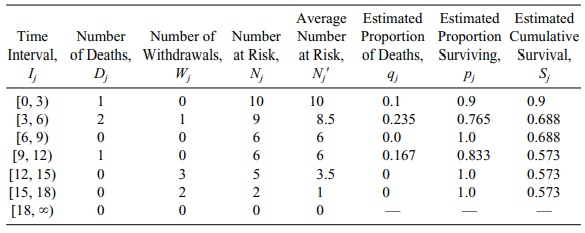Survival Probabilities: Life Tables
| Home | | Advanced Mathematics |Chapter: Biostatistics for the Health Sciences: Analysis of Survival Times
Life tables give estimates for survival during time intervals and present the cumulative survival probability at the end of the interval.
Survival Probabilities
Life Tables
Life tables give estimates for survival during time
intervals and present the cumulative survival probability at the end of the
interval. The key idea for estimating the cumulative survival for both life
tables and the Kaplan–Meier curve is represented by the following result for
conditional probabilities: Let t2
> t1. Let P(t2|t1) = P(X > t2|X > t1),
where X = survival time, t1 = time at the beginning of the interval, and t2 = the time at the end of the interval.
That is, P(t2|t1)
is the conditional probability that a patient’s survival time X is at least t2, given that we have observed the patient sur-viving
to t1. Using this
conditional probability, we have the following product rela-tionship for a
survival curve, S(t), as shown by Equation 15.1:
S(t2)
= P(t2|t1) S(t1)
for any t2 > t1
≥ 0 (15.1)
where
S = survival time
t1 = initial time
t2 = latter time point
For the life table, the key is to use the data in
Table 15.1 to estimate P(t2|t1) at the endpoints of the selected intervals. Remember
that S(t) denotes the survival function. For the first interval from [0, a], we know that for all patients S(0) = 1 and, accordingly, S(a)
= P(a|0); i.e., all patients are alive at the beginning of the interval
and a portion of them survive until time a.
The life table method, also referred to as the
Cutler–Ederer method (Cutler and Ederer, 1958), is called an actuarial method
because it is the method most often used by actuaries to establish premiums for
insuring customers.
Now we will construct a life table for the data in
Table 15.1. We note from the last column that the survival times, including the
censored times, range from 1.5 months to 17.6 months. We will group the data in
three-month intervals giving us seven intervals, namely, [0, 3), [3, 6), [6,
9), [9, 12), [12, 15), [15, 18), and [18, `). (See Table 15.2.) For each interval, we need to determine the number
of subjects who died during that interval, the number withdrawn during the
interval, the total number at risk at the beginning of the interval, and the
average number at risk dur-ing the interval. From these quantities, we compute:
(1) the estimated proportion who died during the interval, given that they
survived the previous intervals; and (2) the estimated proportion who would
survive during the interval given that they sur-vived during the previous
intervals.
Table 15.2 uses eight terms that may be unfamiliar
to the reader. Following are the precise definitions of these eight elements
for a life table:
·
The first column is labeled “Time
Interval.” We denote the jth interval
Ij.
·
The number who die during the jth interval is Dj. (Dj
counts all of the patients whose time of death occurs during the jth interval.)
·
The number withdrawn during the jth interval is Wj. (Wj
counts all of the pa-tients whose censoring time occurs during the jth interval.)
·
The number at risk at the start
of the jth interval is Nj. (This is the number of
subjects who entered into the study minus all deaths and all withdrawals that
occurred prior to the jth interval.)
·
The average number at risk in the
jth interval Nj’ = Nj –Wj/2. Referring to the second row of Table 15.2 under
column Nj’, Nj’ = Nj
– Wj/2 = 9 – ½ = 8.5. The
term Nj’ reflects an actuarial technique to account for the
fact that Wj of the
patients who were at risk at the beginning of the interval are no longer at
risk at the end of the interval.
·
Nj’ represents
the average number of patients at risk in the interval when the withdrawals occur uniformly over the
interval. We use Nj’ to improve the esti-mate of the probability of not
surviving during the jth interval. We
define qj = Dj/Nj’ and
assert that Dj/Nj’ is better than using Dj/Nj or Dj/Nj+1,
where Nj+1 is
the number at risk at the start of the j
+ 1 interval. We then define the estimate of the conditional probability of
surviving during the interval given that the pa-tient survived during the
previous j – 1 intervals as pj. The estimate for
surviv-ing past the jth interval is
obtained by using the conditioning principle given in Equation 15.1. In Table
15.2 (second row), qj = Dj/Nj’ = 2/8.5
= 0.235.
·
The estimated proportion
surviving during the interval is pj.
From Table 15.2 (second row), pj
= (Nj’ – Dj)/Nj’ = [(8.5 –2)/8.5] = 0.765.
·
The cumulative survival estimate
for the jth interval is denoted Sj and is de-fined
recursively by Sj = pj Sj–1.
The method of recursion allows one to calculate a
quantity such as Sn by
first calculating S0 and
then providing a formula that shows how to calculate S1 from S0.
This same formula then can be used to calculate S2 from S1
and then S3 from S2 and so on until we get Sn from Sn–1. In the method of recursion, the
equation is called a recursive equation. A calculation example will be given in
the next section. Refer to Table 15.2 to see the terms that we defined in the
list above.
TABLE 15.2. Life Table for Survival Times for Patients Using Data from
Table 15.1 (N = 38)

Related Topics
